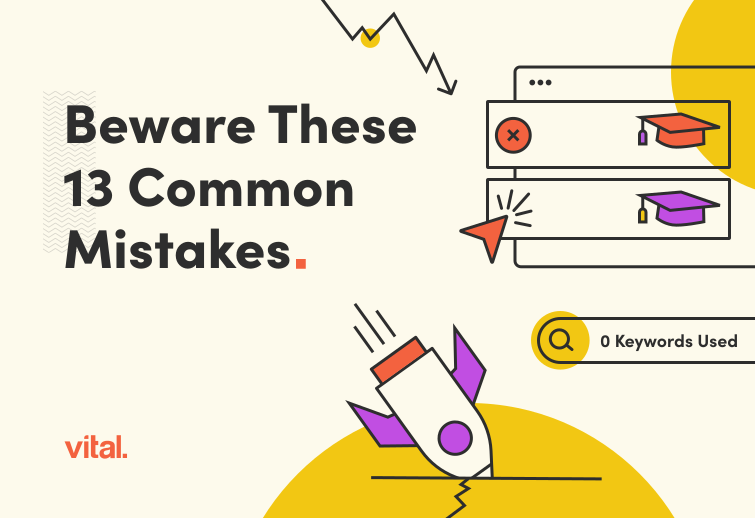With the introduction of ChatGPT and other AI tools for writing, some marketers are predicting that AI will replace professional copywriters for SEO and content marketing. If you’re involved with content marketing, you may be wondering if AI is a faster, less costly alternative to professional copywriting.
Tl;dr: At Vital, we generally don’t use ChatGPT or other generative AI tools to create marketing content from beginning to end. (Nor do we recommend it to our clients for that purpose.) However, we do use these tools to help us strategize, outline, create partial first drafts, kickstart our creativity, and do our jobs more effectively and efficiently. Read on to find out more.
Caveat: This post focuses on ChatGPT, which is only one form of generative AI. By their nature, all the AI tools out there, including ChatGPT, are constantly changing and growing their capabilities — and new tools and applications are being rolled out at a breathtaking pace. That means our recommendations and best practices are a moving target, so stay tuned for breaking news on topics like AI generative search, AI graphic design, and more.
Don’t want to miss a thing? Sign up for our email newsletter to get all the latest updates.
What Is ChatGPT?
ChatGPT is one of the latest additions to the field of “generative AI tools,” or tools which use artificial intelligence to create content. Originally released in late November 2022, ChatGPT uses a chatbot interface to generate text responses to users’ queries. ChatGPT responds to natural language prompts using natural language — in other words, it feels pretty close to communicating with a human. According to an article in The Wall Street Journal, “it can have conversations on topics from history to philosophy, generate lyrics in the style of Taylor Swift or Billy Joel, and suggest edits to computer programming code.”
The tool’s capabilities were updated and enhanced with the release of GPT-4 in mid-March 2023.
How Does ChatGPT Work?
ChatGPT is built on something called a “large language model” or L.L.M. In simplified terms, that means the tool has been fed with huge amounts of language data, both from the Internet (pre-2021) and from real-time conversations with actual humans, in order to learn patterns that allow it to mimic human grammar and writing structure. ChatGPT also has the ability to analyze and describe the contents of images.
To get a little more technical, the “GPT” in ChatGPT stands for Generative Pre-trained Transformer. In this context, a “transformer” is an algorithm that detects patterns in data. According to another article in The Wall Street Journal, a language-based transformer like ChatGPT “learns to predict not just the next word in a sentence but also the next sentence in a paragraph and the next paragraph in an essay.”
In addition to its ability to generate text that mimics something a person would write, ChatGPT fine-tunes its skills through its real-time interactions with humans, so it is able to hold a fairly convincing conversation involving multiple prompts and responses.
You can learn more about how L.L.M.s like ChatGPT work in this article in The New York Times.
What Are ChatGPT’s Limitations for SEO and Content Marketing?
OpenAI, the creators of ChatGPT, aren’t shy about sharing what the tool can and cannot do well. If you’ve ever used ChatGPT yourself, you’ll be familiar with the guidance on the tool’s front page:
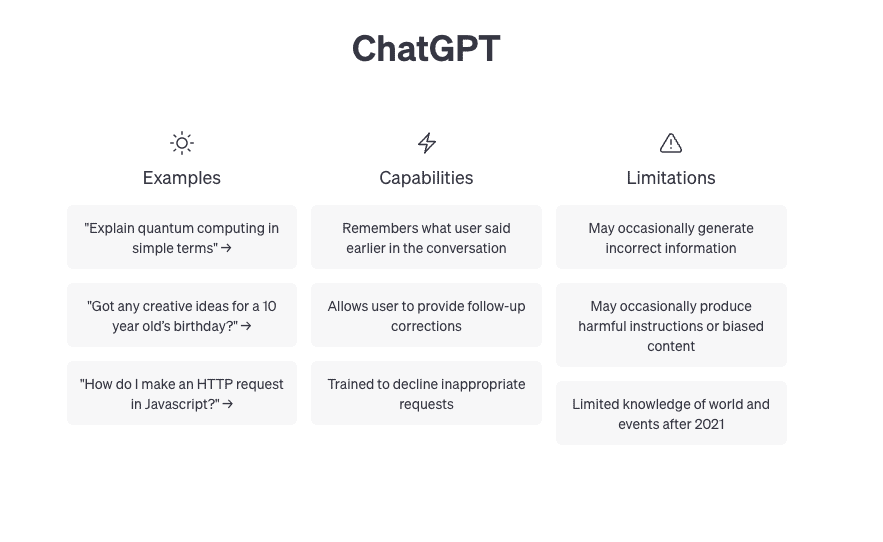
The three big limitations listed here are:
- May occasionally generate incorrect information. In our experience, this is a bit of an understatement. As an artificially intelligent language model, ChatGPT lacks the ability to tell fact from fiction. It replicates language patterns; quite often, those language patterns get mixed and matched in a way that doesn’t align with reality — or even make much sense.
- May occasionally produce harmful instructions or biased content. This is an extension of the above. Just as it lacks critical thinking and fact-checking skills, ChatGPT doesn’t have a moral compass. If a prompt leads it to find language patterns that are potentially harmful or hateful, ChatGPT faithfully reproduces them according to its programming. This is particularly important for content creators in “Your Money, Your Life” (YMYL) fields like healthcare, finance, and law.
- Limited knowledge of world events after 2021. ChatGPT was trained on content generated prior to 2021. On its own, ChatGPT does not have access to the internet, although with the release of GPT-4 in March 23, OpenAI added support for plug-ins that do allow the tool to connect to the web. For the time being, the plug-ins are built for specific purposes such as trip planning. (Read more here.) Over time, we expect to see this scope widen, but for the moment, you can’t rely on ChatGPT for up-to-date information on most topics — nor can it accurately summarize or react to specific content on the internet.
In addition to the big three listed above, ChatGPT has plenty of other limitations when it comes to writing content. We’ll go into more detail in our reasons we use caution when generating content with AI tools, but the short story is that artificial intelligence is great at many things — but it can’t write based on firsthand experience or years of expertise. If you’ve ever had a “conversation” with ChatGPT, you know how convincing it can be — almost enough, sometimes, to make you forget that it cannot actually “understand” the topics it generates content on.
If you ask it about the most popular breeds of dogs and their characteristics, it will very quickly return an answer that sounds pretty good and may or may not be accurate. But it doesn’t know what a dog is. It has no rich history of experience with dogs. To get sappy about it, it has never loved or been loved by a dog. You can also prompt it to generate language patterns that are unexpected and novel, but they won’t be based on insight or creativity, and they likely won’t make much sense.
6 Ways We Use ChatGPT for SEO and Content Marketing
All that said, Generative AI is a powerful tool if you know how to use it well. It has applications in everything from computer programming to meal planning. For our purposes, we’ll focus on how we use it for content marketing strategy, research, and inspiration — as well as first drafts for certain types of content.
Note that, for all the hype around ChatGPT, we’ve been using AI writing tools for years, and we are continually honing our skills in this area.
1. Coming Up with Topic Ideas
Rich, relevant written content forms one of the cornerstones of our approach to digital marketing. For that reason, we are always thinking of new ideas to write about that will drive traffic and ultimately more leads and conversions for our clients. Our process for generating ideas is part science (think keyword research, Google trends, competitive research, etc.) and part art (knowing our clients’ audience and finding ways to address their pain points and offer them something of value).
We use ChatGPT to help us generate topic ideas at scale by giving it relevant information about our audience, subject matter, etc. We then take those ideas and run them through our data-driven litmus test to select the ones that are worth greenlighting.
2. Generating Titles and Headlines for A/B Testing
A writer with a Thesaurus is a powerful thing; a writer with ChatGPT is even more powerful. Using generative AI, we are able to much more rapidly come up with long lists of alternatives for things like blog post titles and PPC ad headlines for testing. Rather than starting with a blank page, our copywriters and content strategists are able to sort through ChatGPT’s “ideas,” pick the ones that work the best, and iterate on them from there.
3. Creating Topic Outlines
Once we choose a topic, we often use ChatGPT to produce a first-draft outline of the content that should be included in a blog post, article, eBook, or other resource. We then add, subtract, and reorganize based on our knowledge of the topic and the audience, as well as input from our clients’ internal subject matter experts.
4. Conducting (Very) Preliminary Research
This one comes with a big caveat based on the limitations we covered above: While ChatGPT can be a powerful aid to research, it needs to be rigorously fact-checked, and it shouldn’t be used for topics like current events. However, we do sometimes use the tool to start the research process. Usually, that looks something like taking an approved content outline and asking ChatGPT to generate bullet points or short-paragraph responses for each subject heading. We check the answers against reliable sources including reputable online publications and real-life subject-matter experts. Then, our awesome copywriting team gets to work creating the actual content for publication.
5. Generating Partial First Drafts for Some Types of Content
Every piece of content we create for our clients is designed to add unique value to the content landscape. That means we leverage subject matter experts, original research, and good old fashioned creativity and innovation to write content that says something new and interesting — and ChatGPT can’t do that.
That being said, there are scenarios where we use ChatGPT to write parts of a blog post or other piece of marketing content. To decide when to use AI and when to rely on internal and client expertise to create original content, we use a simple three-step litmus test:
- Does the content outline contain sections that are intended to summarize common knowledge on a subject? If YES, we may use ChatGPT to draft these sections.
- Do these sections require up-to-date data or information? If NO, we may use ChatGPT.
- Will readers of these sections have high expectations for content that follows Google’s E-E-A-T guidelines for experience, expertise, authority, and trustworthiness? (Particularly experience and expertise.) If NO, we may use ChatGPT.
For example, if we are writing a blog post for a higher education client about job prospects for a particular degree, the post will likely contain a list of common career paths for people with that degree. We may use ChatGPT to write a first draft of this list. The post will also include guidance from our client’s subject-matter experts on things like current salary information, unconventional career opportunities, and informed predictions about the future job market. We write these sections from scratch based on client interviews and research.
6. Kickstarting Brainstorming Sessions
One of the most fun ways to use ChatGPT is to jumpstart the creative process. Our writers and strategists have become experts in working with and around the tool’s inherent lack of creativity to generate ideas we might not have thought of on our own — and coming up with loads of variations on a theme to get our creative juices flowing.
For example, I asked ChatGPT to come up with titles for this blog post based on the cliche “The Good, the Bad, and the Ugly.” It took a few prompts to get there, but it came up with these:
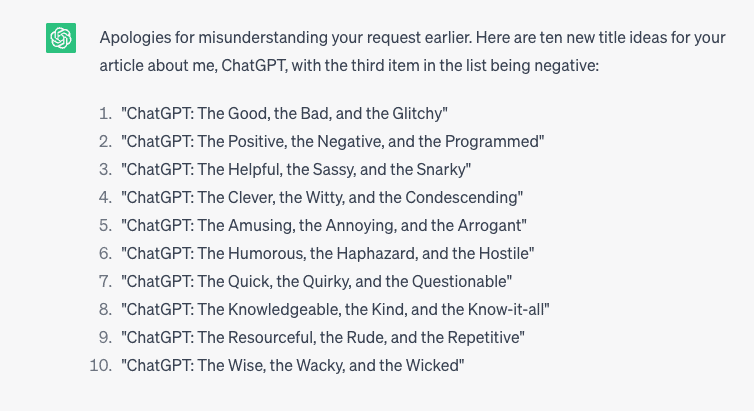
None of them quite hit the mark, but “ChatGPT: The Quick, the Quirky, and the Questionable” is pretty good! We’ve used a similar process for generating ideas for everything from brand names to captions for social media posts.
6 Reasons to Proceed with Caution when Using ChatGPT
You probably noticed one big thing that’s missing from the list of ways we use ChatGPT for content marketing: writing complete content. That’s because we usually don’t use ChatGPT to write content from beginning to end. That’s not just because we have an insanely talented and experienced copywriting team that blows ChatGPT out of the water in terms of skill and creativity. It’s also because most content produced by ChatGPT doesn’t meet best practices for SEO and content marketing performance. Here’s why:
1. AI-written content often doesn’t meet Google’s SEO standards, including E-E-A-T
You may know that Google uses something called E-E-A-T, which stands for “Experience, Expertise, Authority, and Trustworthiness” to measure the quality of content for its search engine ranking algorithms. AI inherently lacks expertise, authority, trustworthiness – and most notably, real-world experience – all of which Google prioritizes for SEO.
Even if ChatGPT manages to generate content that appears to Google to have E-E-A-T, the truth is that Google doesn’t just evaluate the words in a piece of content; it also evaluates how real people interact with the content, through clicks, dwell time, high-quality backlinks, etc. Those interactions allow Google to determine how valuable content actually is to real people.
While AI may be great at some things, like finding answers to common questions, it lacks the ability to add the kind of value that people expect from authoritative, expert sources. Especially for the kind of in-depth content we frequently produce for our clients, ChatGPT isn’t up to the task — and if searchers aren’t finding the insights they expect, Google is not going to prioritize that content in search results.
2. AI-generated content carries a high risk of plagiarism and improperly cited sources
ChatGPT pulls from a mind-boggling data set of content patterns to produce its writing. Because its output is a patchwork of previously-existing writing, you really have no way to know where it’s getting its information. As we’ve mentioned, it gets things wrong a lot. It also reproduces source material verbatim without citing it. And, if you ask it to produce a source, it will in fact produce convincing – yet completely fabricated – citations.
For example, I asked ChatGPT to find a specific type of quotation:
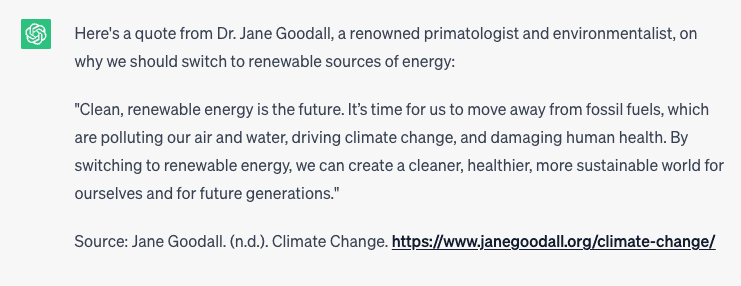
Sounds pretty good, right? Jane Goodall is definitely a reputable, expert source. But here’s what happens when I click the link:
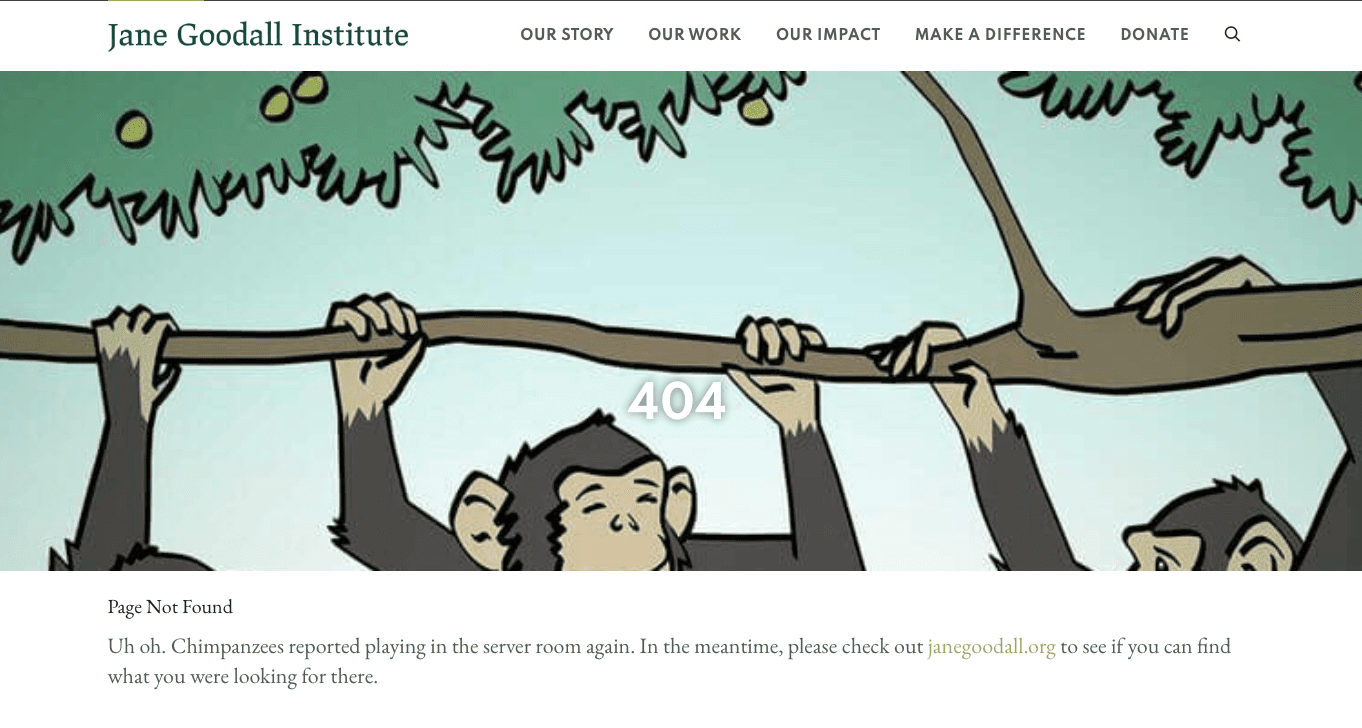
I get a 404 error, because the link doesn’t exist. If I type the quote into Google just to see if it does, in fact, live somewhere online, I get nothing. ChatGPT made it all up. (And it’ll do it again, every single time I ask for a citable quotation, because, remember, without a specific plug-in, it doesn’t have access to the internet.)
3. ChatGPT is known to produce content that is inaccurate and even harmful
As we discussed above, ChatGPT and other L.L.M. AI tools lack the ability to evaluate content for accuracy or the potential to create harm. Without human oversight, hate speech, discriminatory language, false claims, and other harmful content is a real danger. That’s why, again, it’s especially important never to use AI to produce content for YMYL topics.
4. Software can already tell the difference between AI-generated content and content written by a human – and it’s only getting better.
If you think AI is a way to save time and money without anyone being the wiser, you’re probably wrong. Even if AI can fool a human reader (and it very often cannot), new tools are increasingly able to spot AI-generated content. As these tools get better, we expect to see Google penalties and other fallout from using certain types of AI-generated content.
Note that for now, Google’s official policy is that it doesn’t penalize “appropriate” use of AI-generated content. We could dig pretty deep into what Google might mean by “appropriate,” but the takehome is that if your content isn’t providing value to searchers, especially through E-E-A-T, it’s not going to pass muster with Google. You can read more about Google’s AI-content guidelines here.
5. AI kills your brand’s competitive advantage
AI models are programmed to learn from data and replicate patterns. They lack the human empathy and creativity that are essential for effective storytelling, connecting with readers emotionally, and creating unique, memorable content. AI tools can’t put themselves in your audience’s shoes, understand their pain points, or address them in novel ways that differentiate your brand.
One of the most telling characteristics of AI-generated content is that is sounds like content that already exists. AI writing often lacks personality and authenticity, making it easy to tune out in a noisy, crowded landscape. Undoubtedly, some of your competitors will use AI to generate content for SEO and other marketing purposes at scale. If you join them, you’ll sound just like them. This is a great opportunity to use the unique skills of human writers to make sure your brand stands out from the crowd.
6. Google is deindexing AI content
Google’s latest algorithm updates have come as a direct response to AI content. The SEO community has seen multiple AI-driven websites completely drop off the search results page (i.e., if you search for the brand in Google, the website doesn’t appear!). We believe Google will continue accelerating its learnings to identify AI-created content and punish those who take advantage of the tool. We have not swayed from our take on writing content and believe the most valuable content:
- Draws upon industry knowledge, qualifications, and education to offer expert insights.
- Harnesses proprietary data to lend authenticity to your insights.
- Is anchored in real-world use cases and experiences that can’t be easily replicated.
Remember that the purpose of SEO content marketing is not only to increase traffic via keyword rankings. Ultimately, you need to convert a measurable percentage of that traffic into leads (and ultimately customers) in order to drive business value. Without original insights, examples, and other experience-driven content, readers are less likely to view your brand as an authoritative, empathetic source of information — and less likely to convert to customers as a result.
And now, with Google’s algorithm updates, even traffic isn’t a given when it comes to AI-generated content. To hear more about our thoughts on the future of AI, check out our recent interview with Website Planet.
Conclusion
AI is awesome for lots of digital marketing applications. But when it comes down to it, marketing is an H2H business – that is, human to human – and in an increasingly impersonal marketing landscape, we think making human connections through content matters. So let’s not forget what it’s all about: humans solving human problems and offering value to other humans. If the robots can help, they’re welcome aboard. But let’s not have them steer the rocketship.
